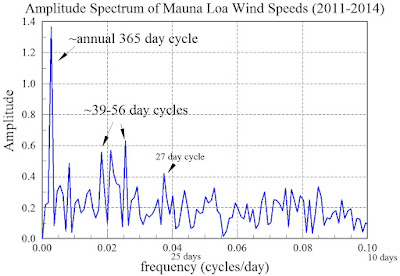Basic Data Analysis
CO2 data provided through the Future Learn Course "Data Science for Environmental Modelling and Renewables Atmospheric concentrations of CO2 measured on the summit of Mauna Loa on the Big Island of Hawaii show annual oscillations superimposed on a long term rise (Figure 1). The best fit quadratic (Figure 1) provides 0.997 correlation to the long term CO2 trend.
Figure 1: Atmospheric CO2 Concentrations 1952-2018 - Mauna Loa, Hawaii.
Some shorter period annual oscillations about the best fit line can be observed (Figure 1). A plot of the residual (Figure 2) emphasizes these variations. The annual variations about the best fit quadratic are on the order of 6 ppm.
Figure 2: Residual atmospheric CO2 concentrations. The annual cycles are pronounced.
I take a spectral filtering approach to remove the annual cyclical rise and fall of CO2 from the data. The spectrum of the residual reveals some pronounced peaks associated with the annual variation and its harmonics (Figure 3). Ideally we would like to eliminate the annual cycles and harmonics. This is easily done using a low pass filter. The region of interest is shown in the lower frequency end of the spectrum (Figure 3).
Figure 3: Amplitude spectrum of residual Mauna Loa CO2 concentrations.
I applied a low pass filter with a 0.06 cycle/month (cpm) cutoff frequency to eliminate the annual variations. The low pass filtered output (Figure 4) matches the unfiltered spectra at low frequency and is 0 for frequencies greater than 0.06cpm.
Figure 4: Low pass filtered output spectrum (red) shown
along with the unfiltered residual spectrum.
A close up view of the spectrum from 0 to 0.1 cpm highlights the effect of filtering (Figure 5). The large annual peak (black) present in the unfiltered residual has been removed in the filtered output (red). The filtered residual contains some long period (low frequency) peaks that are further enhanced when plotted separately (Figure 6).
Figure 5: Filtered (red) and unfiltered (black) CO2 residual spectra.
In the closeup view the low frequency response in the residual is enhanced (Figure 6). We see peaks at approximately 30 and 15 year cycles.
Figure 6: Low pass filtered residual CO2 concentration spectrum.
Period in years of some peaks are labeled.
Peaks that might be associated with solar intensity (sunspot cycle) variation are noted around 9 cpm. An additional peak with a period of about about 4 years is also present in the data. The largest amplitude oscillations in the residual have a period of about 30 years. One wonders how local volcanic emissions from the East Rift zone may have contributed to some of these local variations.
The filtered and unfiltered output are shown for reference (Figure 7). Low pass filtered output suggests reveals the form of the subtle long and short period variations superimposed on the overall quadratic rise in CO2 concentration since 1959.
Figure 7: Low pass filtered and unfiltered residual CO2 concentrations.
Is there a relationship between solar energy output to some of the fluctuations we see in the residual? Does increased solar radiation enhance plant growth O2 production and CO2 depletion? The comparison of long period residual CO2 oscillations with solar intensity variations (Figure 8) indicates there is little case to be made for any influence of 11 year sunspot/solar intensity variations on CO2 fluctuations. However, a relationship could lie in the amplitude of the annual CO2 cycles.
Figure 8: Comparison of low pass filtered residual CO2 concentrations
with solar intensity variations.
Comments
- The 59 year record of CO2 variations on the summit of Mauna Loa, Hawaii increase from about 316 ppm to 407 (mid 2017).
- The rising CO2 concentrations are accurately modeled using a quadratic relationship with correlation coefficient of 0.997. This is only slightly better than an exponential fit that yields a correlation of 0.992.
Spectral analysis and filtering have been used to evaluate the Mauna Loa CO2 data.
- The amplitude spectrum shows a pronounced peak for the annual frequency. Tree harmonics are also present.
- The filtered spectrum reveals a complex frequency response in the CO2 variations over the 59 year record of observation.
- We observe prominent cycles with periods of approximately 30, 15 9 and 4 years.
- These variations are subtle and of the order of +- 1ppm.
- The CO2 rise observed on Mauna Loa without annual variations is shown in the low pass filtered output (Figure 9).
Figure 9: Long term variations in atmospheric CO2 concentrations.
Annual cycles removed.
As discussed in the class module
2.7 Trend and Seasonal Effects the trend in this data is quadratic although some would be on firm ground to argue exponential. The seasonal effect is easily recognized in the data as annual sinusoidal. The unexplained variations (eg. Figure 8) does not appear random. Understanding the significance of these variations would require some additional study, perhaps of local volcanic emissions. The annual effect was not extracted as a separate time series but could have been using a bandpass filter. We could then reconstruct the original data using an additive model approach with CO2 variations = sum of long term quadratic trend + unexplained variation + seasonal.

























